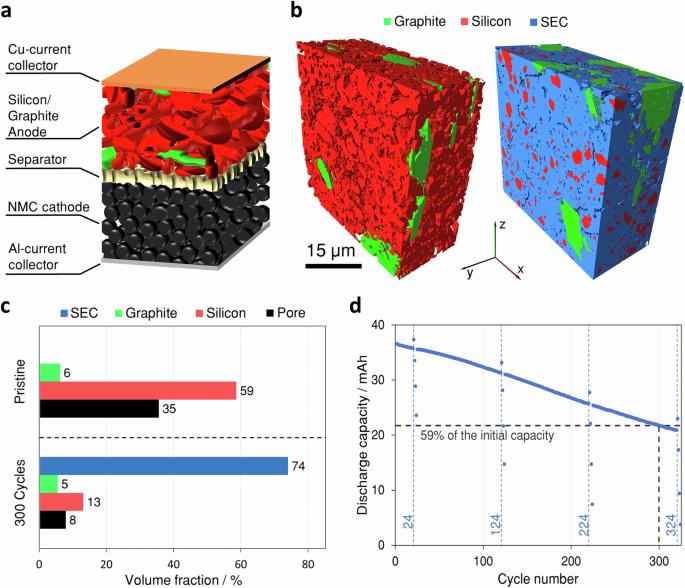晶体硅阳极中无定形剪切带的形成制约着锂离子电池的锂化和容量衰减
IF 7.5
Q1 MATERIALS SCIENCE, MULTIDISCIPLINARY
引用次数: 0
摘要
锂离子电池的循环稳定性通常归因于固态电解质间相(SEI)层的形成,SEI层是在电池运行过程中发生电化学反应时在活性材料表面生成的。硅在锂离子的插入和提取过程中经历了巨大的体积变化,由于锂离子渗透到硅中,导致硅界面的非晶化。在这里,我们发现了在电化学循环过程中产生的非静水应变如何进一步引发位错,并最终在晶体硅核心中形成剪切带。后者促进了硅界面的非均匀锂化,影响了 SEI 重整过程,并最终影响了容量。我们的研究结果基于全面的多尺度结构和化学实验表征,并辅以分子动力学建模。这种方法强调了考虑电化学、微结构和机械机制的重要性,为开发具有更高的循环稳定性和更低的容量损失的改良阳极材料提供了一种策略。硅在锂插入和提取过程中会发生巨大的体积变化,从而影响锂离子电池的内部结构。在此,我们研究了电化学循环时非静水应变如何影响晶体硅核心的机制。本文章由计算机程序翻译,如有差异,请以英文原文为准。

Amorphous shear band formation in crystalline Si-anodes governs lithiation and capacity fading in Li-ion batteries
The cycling stability of Li-ion batteries is commonly attributed to the formation of the solid electrolyte interphase (SEI) layer, which is generated on the active material surface during electrochemical reactions in battery operation. Silicon experiences large volume changes upon the Li-insertion and extraction, leading to the amorphization of the silicon-interface due to the permeation of the Li-ions into the silicon. Here, we discover how generated non-hydrostatic strain upon electrochemical cycling further triggers dislocation and eventually shear band formation within the crystalline silicon core. The latter boosts the non-uniform lithiation at the silicon interface affecting the SEI reformation process and ultimately the capacity. Our findings are based on a comprehensive multiscale structural and chemical experimental characterization, complemented by molecular dynamics modelling. This approach highlights the importance of considering electrochemical, microstructural and mechanical mechanisms, offering a strategy for developing improved anode materials with enhanced cycling stability and reduced capacity loss. Silicon undergoes large volume changes during lithium insertion and extraction, affecting the internal lithium-ion battery structure. Here, the mechanisms of how non-hydrostatic strain upon electrochemical cycling affects the crystalline silicon core was investigated.
求助全文
通过发布文献求助,成功后即可免费获取论文全文。
去求助
来源期刊

Communications Materials
MATERIALS SCIENCE, MULTIDISCIPLINARY-
CiteScore
12.10
自引率
1.30%
发文量
85
审稿时长
17 weeks
期刊介绍:
Communications Materials, a selective open access journal within Nature Portfolio, is dedicated to publishing top-tier research, reviews, and commentary across all facets of materials science. The journal showcases significant advancements in specialized research areas, encompassing both fundamental and applied studies. Serving as an open access option for materials sciences, Communications Materials applies less stringent criteria for impact and significance compared to Nature-branded journals, including Nature Communications.
 求助内容:
求助内容: 应助结果提醒方式:
应助结果提醒方式:


